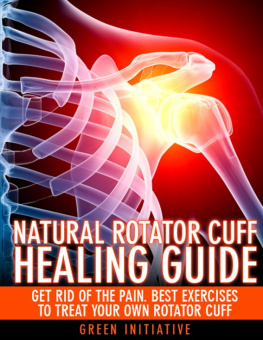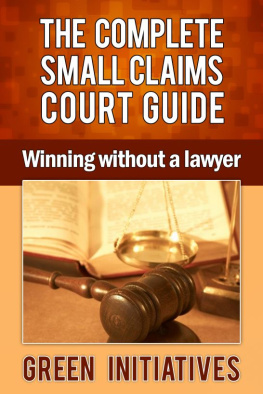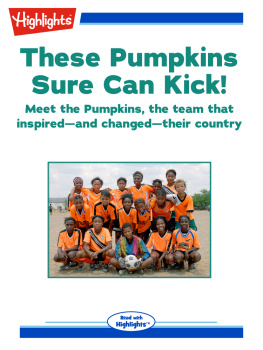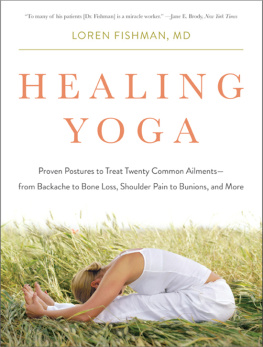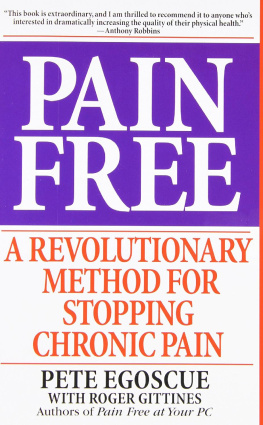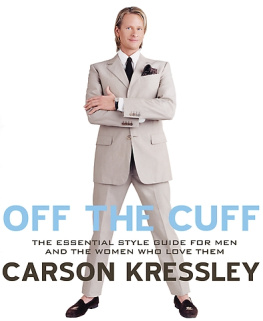ROTATOR CUFFS
By Green Initiative
Smashwords Edition
Copyright 2012 Green Initiative
All Rights Reserved
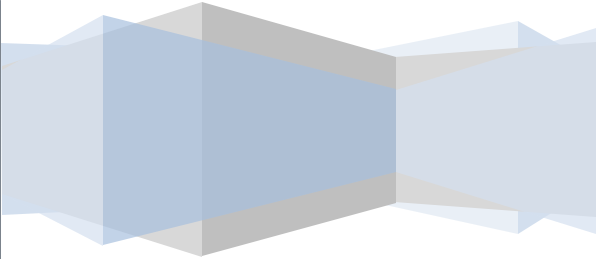
Smashwords Edition, License Notes
This ebook is licensed for yourpersonal enjoyment only. This ebook may not be re-sold or givenaway to other people. If you would like to share this book withanother person, please purchase an additional copy for eachrecipient. If youre reading this book and did not purchase it, orit was not purchased for your use only, then please returnto Smashwords.com and purchaseyour own copy. Thank you for respecting the hard work of theauthors.
Table of Contents
INTRODUCTION
Rotator cuff injuries can occur toboth athletic and non-athletic individuals. Some of the mostsignificant symptoms sufferers complain about include pain,weakness and a limited range of motion in theirshoulders. It is important to consult a healthcareprofessional early on to determine the causes. The most effectivetreatment method and steps to prevent further injuries to themuscles and joints involved will depend on the diagnosis.
Results from studies reveal that rotator cuffdisease is more common among men over 40 years old and the averageage when it starts to manifest itself is estimated to be 55 yearsold. The disease becomes more prevalent with advancing age. Foryounger people, the disease occurs mostly because of muscleimbalance, slight instability and overuse while for older patientsit is due to chronic degeneration. About 15% of patientscomplaining of shoulder pain aged 70 and above were found to haverotator cuff injuries. Investigators have found two significantfacts about 40% of those who reported having rotatorcuff disease have never done heavy physical work and that manyworkers who performed heavy physical work never developed rotatorcuff diseases.
There is no evidence that says rotatorcuff diseases is associated with any particular race but withregards to sex, the results vary and appear to beinconsistent. One study showed that more than half of thosewho sought medical consultation for rotator cuff diseases weremen but in another study, the number was equally dividedbetween the two sexes.
We can better understand how rotatorcuff diseases happen by knowing the mechanicaland normal anatomical structure of the shoulder itself and therotator cuff which forms part of the shoulder structure. Wewill be discussing the muscles and joints of the rotatorcuffs and their functions. This will prepare us to see in abetter light how injuries occur and identify the type ofrotator cuff injuries. We will also know when toseek medical help and the treatment methods available.
Rotator cuff injuries are preventable so we willalso deal with ways to avoid such injuries. Finally, we will try toanswer whats in store for those who have survived and continue todeal with their pain and limited range of motion.
Chapter 1 TheShoulder Structure
The shoulder is made up of complex interactingstructures. It has many moving parts and so just like anymachinery, it is subject to occasional breakdowns due to the wearand tear of constant rubbing. Its design however, has provided formaximum range of movements and mobility. The shoulder joint helpsyou lift objects, throw a baseball, and swing your golf club.
A. Anatomy ofthe Shoulder
There are several important structures that makeup our shoulder. The most important ones are the bones and joints,ligaments and tendons where the rotator cuff belongs, nerves, bloodvessels and bursae.
The bones that make upthe shoulder are the scapula (shoulderblade), the humerus (upper arm bone), andthe clavicle (collarbone).
It is the rotator cuff, through thetendons that attach the muscles to the bones that connectsyour humerus to the scapula. The rotator cuff musclesmove the bones by pulling on the tendons. It is the functionof the rotator cuff to help raise and rotateyour arm.
When you raise your arm, it is the rotatorcuff that keeps the humerus tightly pressed inthe glenoid (socket of the scapula).The scapulas upper part or the roof of theshoulder is referred to as the acromion.
Between the acromion and the tendons of therotator cuff is a bursa, sac of tissue that prevents too muchfriction between these two moving parts. They are found in manylocations in your body where parts move and rub together.
B. Anatomyof the Rotator Cuff
Rotator cuff is not a single muscle or joint butrather a set of four tendons that attach corresponding fourshoulder muscles to the bones of the upper arm (humerus).Tendons or sinews are strands of flexible tissues and are madeup of collagen proteins. They are the connections between musclesand bones. The reason these are called rotator cuff is becausethese tendons make it possible to rotate the arm within shoulderjoint socket. The rotator cuff keeps the arms andshoulder together and allows the arm to move in differentdirections and rotate. The upper arm is actually capable ofassuming over 1600 positions.
We have several joints in our bodies but themost versatile one is located at the shoulders. Compared to otherjoints, a healthy shoulder has a wider range of motion. It can movein more freely in all directions. Its versatile movement allows usto perform hundreds of activities from changing a light bulb toswinging a golf club.
The shoulder has a unique structure that allowsthis wide range of motion. It is a ball and socket joint, just likethe hip. There is a ball at the top end of the humerus (upper armbone) that fits exactly into a socket of the scapula (theshoulder blade). The hip joints however have a deeper socketwhile the shoulders have a shallow one. While this unique structureallows more freedom of movement it also gives the shoulderlimited stability and leads to frequent dislocation and chronicproblems of the joints which can be excruciatinglypainful and affect a persons quality of life. Such injuries canstop a person from performing everyday tasks.
1. Muscles of the Rotator Cuff
The rotator cuff is a group of four muscles andtheir tendons that connects them to the arm bone. They combineto stabilize the shoulder. They also work together to elevateand rotate the arm. All four muscles originate on the scapula(shoulder blade) and insert on the humerus (upper armbone). To remember them easily, you can use the mnemonicS.I.T.S.
a.Supraspinatus
This muscle is responsible for raising the arm (referred toas abduction in medical journals) and moving it away fromyour body. It works together with the other muscles of the rotatorcuff in stabilizing the head (ball) of the upper arm(humerus) by keeping it securely pressed inthe socket of the shoulder joint.
b.Infraspinatus
This muscle assists the lifting of the arm as you turnit outward (external rotation). It is a thick,triangular-shaped muscle.
c. TeresMinor
This is a narrow, elongated muscle that alsohelps in the external rotation of the arm. It also helps in thelateral rotation of the arms and draws the upper arm bone tothe socket of the shoulder joint.
d.Subscapularis
This muscle is also shaped like a triangle. It isresponsible for the internal rotation of the arm. It depresses thehead of the upper arm allowing its free movement in the shoulderjoint while it is being elevated. It draws the upper arm bonedownward and forward. It is also responsible for preventingthe head of the humerus from being displaced.
2. Functions of the Rotator Cuff Muscles
The mechanics of rotator cuff functions involvemany complex and interrelated movements of muscles and bones. Tounderstand the terms better, imagine a ball and socket type ofjoint and the identity of the bones as described above. Themuscles all work together to maintain the tension on the upper armbone and lock it into the shoulder joint.

